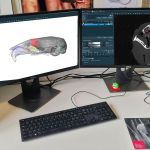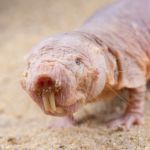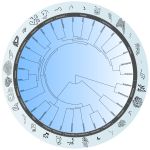Mammalian maxilloturbinal evolution does not reflect thermal biology

This week, an international team published an article that provides new insights into the nose of mammals and its relation to their warm-bloodedness.

Figure: Variations of the relative surface area and shape of the maxilloturbinal between mammalian species. Barplots represent the relative surface area of the maxilloturbinal in 310 species. Blue and red circles respectively represent the minimum and the maximum values from the naked mole-rat (Heterocephalus glaber) and the California sea lion (Zalophus californianus).
The evolution of endothermy in vertebrates is a major research topic in recent decades that has been tackled by a myriad of research disciplines including paleontology, anatomy, physiology, evolutionary and developmental biology. The ability of most mammals to maintain a relatively constant and high body temperature is considered a key adaptation, enabling them to successfully colonize new habitats and harsh environments. It has been proposed that in mammals the anterior nasal cavity, which houses the maxilloturbinal, plays a pivotal role in body temperature maintenance, via a bony system supporting an epithelium involved in heat and moisture conservation. The presence and the relative size of the maxilloturbinal has been proposed to reflect the endothermic conditions and basal metabolic rate in extinct vertebrates.
However, prior to this study, such hypotheses were based on a limited dataset and lacked strong evidence. To properly test these hypotheses, the international team CT-scanned the heads of over 300 mammals from international museum collections.

Figure: 3D representations of the skull and the maxilloturbinal in several species of mammals.
FUN FACT: To include a human representative in their study, the first author used a CT-scan of his own head.

Figure: photos and 3D representations of the head, the skull and the maxilloturbinal of the first author of this study.
Using this technique, they were able to visualize the maxilloturbinal in 3D and quantify it. They demonstrate that neither corrected basal metabolic rate nor body temperature significantly correlate with the relative surface area of the maxilloturbinal.
Contrary to previous hypotheses, the researchers concluded that there is no evidence to support a relationship between the origin of endothermy and the development of the maxilloturbinal.
Instead, they identified important variations in the relative surface area, morpho-anatomy, and complexity of the maxilloturbinal across the mammalian phylogeny and species ecology.
The relative surface area of the maxilloturbinal varies unexpectedly from 6% to 610% of the predicted value. The naked mole-rat and the California sea lion represent the minimum and maximum values, respectively.

Figure: 3D representations of the skull and the maxilloturbinal of the naked mole-rat (Heterocephalus glaber; left) and the California sea lion (Zalophus californianus; right).
Reference: Martinez, Q., Okrouhlík , J., Šumbera, R., Wright, M., Araújo, R., Braude, S., Hildebrandt, T. B., Holtze, S., Ruf, I., Fabre, P. H. Mammalian maxilloturbinal evolution does not reflect thermal biology. Nature Communications 14, 4425 (2023). https://doi.org/10.1038/s41467-023-39994-1















